Ensuring Continuity When Switching Outsourcing Partners
Switching outsourcing partners? This in-depth guide offers actionable strategies, checklists, and real-world examples to help you manage the transition effectively.

Over the years, I’ve navigated the complexities of transitioning between partners. It’s not always easy. It’s gritty work. Yet, it’s vital for growth. When you need to change outsourcing partners, you need to do it right. You need to ensure continuity. You need to avoid losing momentum.

In this post, I’ll share real-world insights and practical tips. I’ll go beyond the basics. I’ll share the detailed steps and industry-specific strategies that have worked for me. These aren’t just theories. They are the product of hard-earned experience. So, if you’re in the middle of an outsourcing transition or planning one, read on. You’ll get an in-depth guide that covers every angle of the process.
Why Switch Outsourcing Partners?
Sometimes you need a change. Sometimes a partner just isn’t the right fit. Perhaps their processes no longer match your evolving needs. Perhaps communication has broken down. Perhaps their technical expertise is outdated. Whatever the reason, the transition can be challenging. But it can also be an opportunity.

Facing the Challenges
Switching outsourcing partners is rarely a seamless process. There are risks involved. A mismanaged transition can lead to delays, quality issues, and even lost knowledge. The data is clear: companies that fail to manage these transitions properly can experience project delays of 30% or more, according to some industry reports. That’s significant. It can derail budgets and timelines.
Yet, with the right plan, you can minimize these risks. You can secure continuity. You can maintain, or even improve, the momentum of your projects. The goal is to move from one partner to another without missing a beat. It’s about preserving the intellectual capital of your project. It’s about keeping your team motivated. And, above all, it’s about ensuring your software stays on track.

A Personal Journey
I’ve been through this. I’ve seen firsthand the disruption a poorly managed switch can cause. I’ve also witnessed the benefits of a meticulously planned transition. There’s nothing more satisfying than watching your projects continue to flourish, even when the vendor landscape changes. In my experience, the key lies in understanding every element of the partnership. It’s about the people, the process, and the technology.
It wasn’t a one-size-fits-all solution. It took careful thought, in-depth planning, and often, a bit of courage to make the change. But the payoff has always been worth it. Today, I want to break down those insights. I want to give you a roadmap that can guide you through the labyrinth of outsourcing transitions.
Understanding Your Current Situation
Before you decide to make a move, you need to understand where you are. That means a deep dive into your current relationship with your outsourcing partner.

Assessing the Relationship
Start by asking yourself some tough questions. What’s working? What isn’t? List out the pain points. Is it the quality of code? The pace of delivery? Communication issues? Or perhaps it’s a misalignment in culture and values? It’s not about laying blame. It’s about gathering facts.
Take stock of your current projects. What knowledge is tied to your existing partner? What documentation exists? What are the key processes that drive your software development? Answering these questions provides the foundation for a smooth transition.
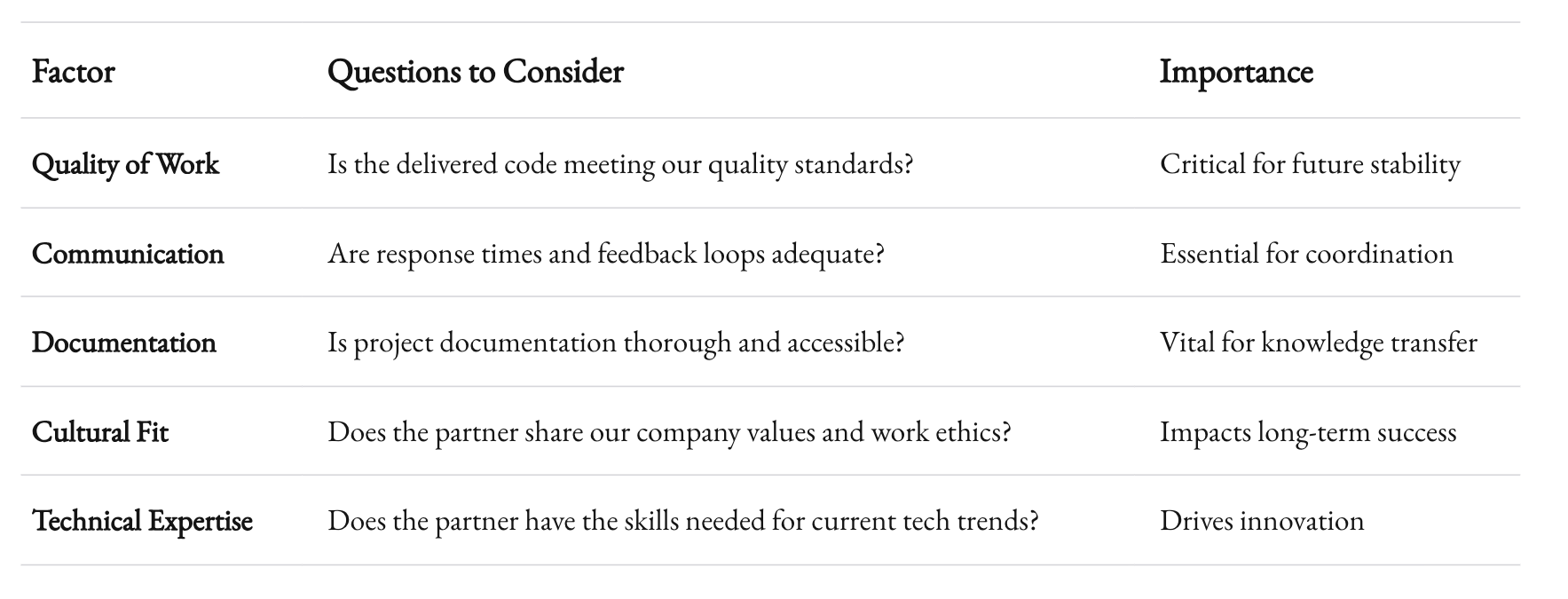
Risk Assessment
Every transition carries risk. You must be proactive in identifying and mitigating them. What are the potential pitfalls? For instance, a loss of critical code documentation can set you back by weeks. A knowledge gap between teams can lead to misinterpretations of project requirements. And then there’s the risk of morale issues among in-house teams.
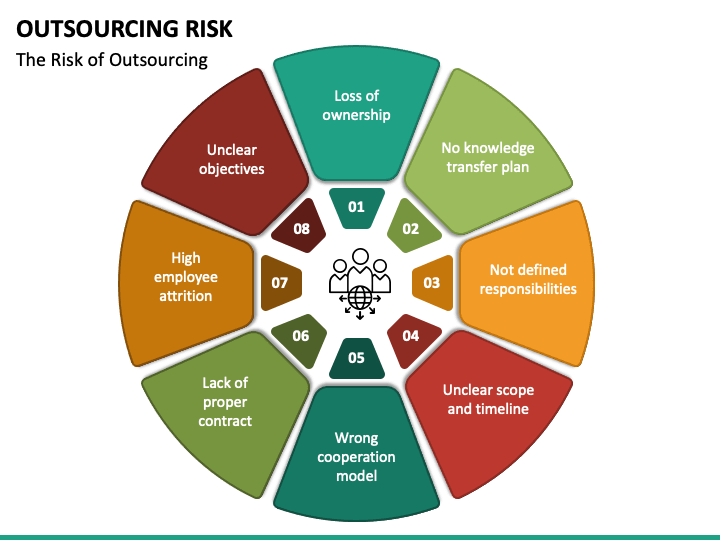
A thorough risk assessment means mapping out all these potential issues. Quantify them when possible. Use historical data to estimate the potential delay each risk might cause. This is not guesswork. It’s informed planning. Industry data suggests that a robust risk management plan can reduce transition-related delays by up to 25% (source: internal benchmarking data at 1985).
Remember, the goal here is not to scare yourself. It’s to be prepared. Once you know the risks, you can design your transition to address them head-on.
Building a Transition Plan
Once you’ve taken stock of your current situation, it’s time to build a transition plan. This plan will be your roadmap. It will guide every step of the process. And it must be detailed.

Define Clear Objectives
The first step is to define what you want to achieve. What does continuity look like for your projects? Does it mean zero downtime? Does it mean a seamless handoff of all code and documentation? Be specific.
Write down your objectives. Make them measurable. For example:
- Objective 1: Achieve zero downtime during the transition.
- Objective 2: Ensure 100% transfer of all relevant documentation.
- Objective 3: Maintain project delivery deadlines with no more than a 5% delay.
These objectives will help guide your strategy and serve as benchmarks for success.

Identify the Transition Team
A transition is not a one-person job. It requires a dedicated team. Identify internal champions who understand the project deeply. These individuals will work closely with the new partner. Their role is to ensure that nothing slips through the cracks.
It’s also critical to involve your in-house project managers and lead developers. They should be the ones bridging the gap between the old and new outsourcing teams. Their intimate knowledge of the project is invaluable.
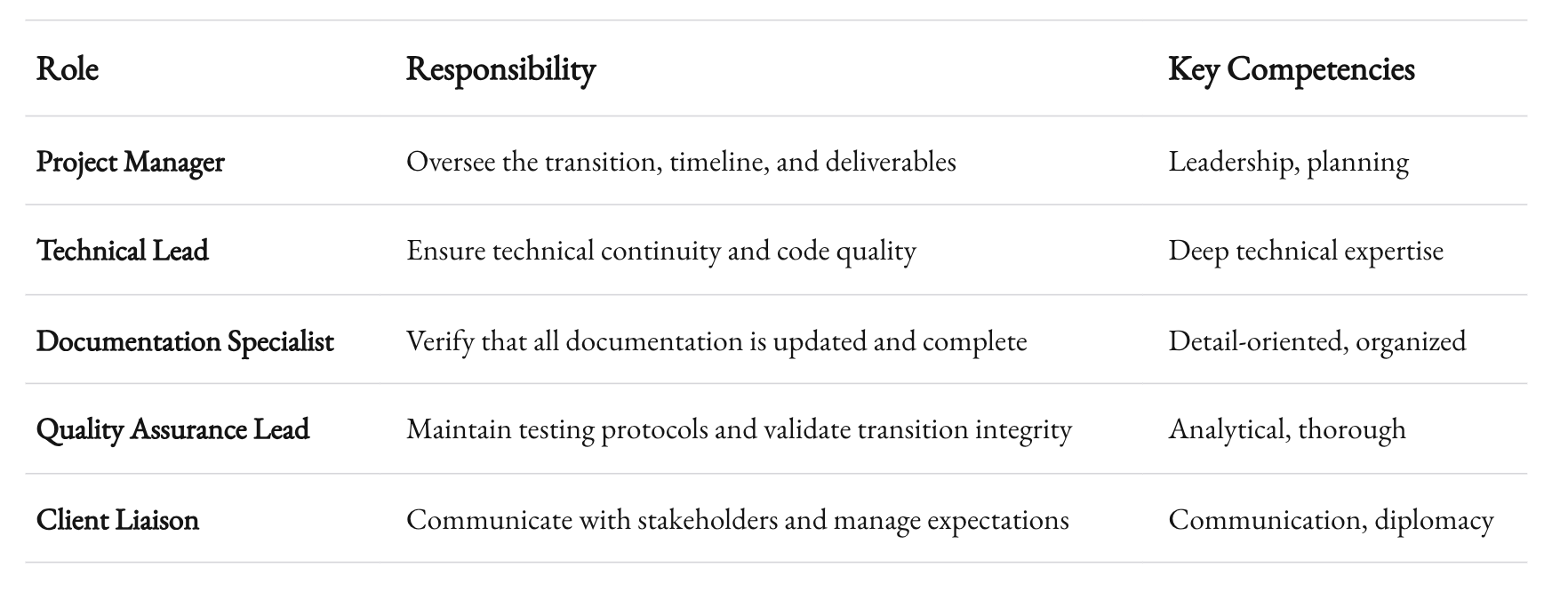
Set a Realistic Timeline
Every transition needs a timeline. And this timeline must be realistic. Building a new partnership takes time. Rushing the process can lead to mistakes that cost more time in the long run.
Break down the transition into phases. For instance:
- Pre-Transition Phase: Gather documentation, perform audits, and set objectives.
- Transition Phase: Begin knowledge transfer, run parallel systems, and start working on minor projects with the new partner.
- Post-Transition Phase: Review performance, refine processes, and fully migrate all responsibilities.

Each phase should have a clear timeline. This timeline is your roadmap. It’s your safety net. And it ensures that everyone involved knows what to expect.
Communication: The Lifeblood of Transition
In any transition, communication is key. It’s not just about handing over documents. It’s about building relationships. It’s about trust. It’s about ensuring that every stakeholder is on the same page.
Transparency with Your Team
Your internal team must be in the loop. Don’t hide the change. Instead, communicate the reasons for the switch clearly. Explain the benefits. Explain how it will impact day-to-day operations. Open, honest dialogue helps alleviate anxiety. It keeps everyone focused on the goal.

Short, punchy updates are crucial. Use quick, clear messages. And back them up with detailed meetings. Combine the brevity of a text message with the clarity of a face-to-face conversation. This dual approach ensures that nothing is lost in translation.
Setting Up Regular Check-ins
Schedule regular meetings during the transition phase. These check-ins serve as touchpoints. They help address issues before they escalate. They also provide opportunities for feedback. This iterative communication loop is essential for adjusting plans on the fly.

Set up a clear schedule:
- Daily Stand-ups: For quick, immediate issues.
- Weekly Review Meetings: To discuss progress and roadblocks.
- Monthly Strategy Sessions: For long-term planning and adjustments.
This structure is proven to work. It keeps all parties engaged. It builds a collaborative atmosphere. And it significantly reduces the risk of miscommunication.

External Communication
Your clients and external stakeholders should also be informed. They need to know that you’re taking steps to ensure continuity. This transparency builds confidence. It reassures them that the transition is under control.

By structuring your communication, you leave less room for misunderstandings. Everyone knows what’s happening and when.

The Handoff: Managing Knowledge Transfer
Knowledge transfer is the backbone of any successful outsourcing transition. It’s the process of moving not just files, but insights, context, and institutional memory.
Inventory and Audit
Start with a thorough inventory of your current knowledge base. Document everything. Code repositories, project management files, user guides, meeting notes—the list is long. And don’t just document what exists. Evaluate the quality of the documentation. Is it up-to-date? Is it comprehensive?
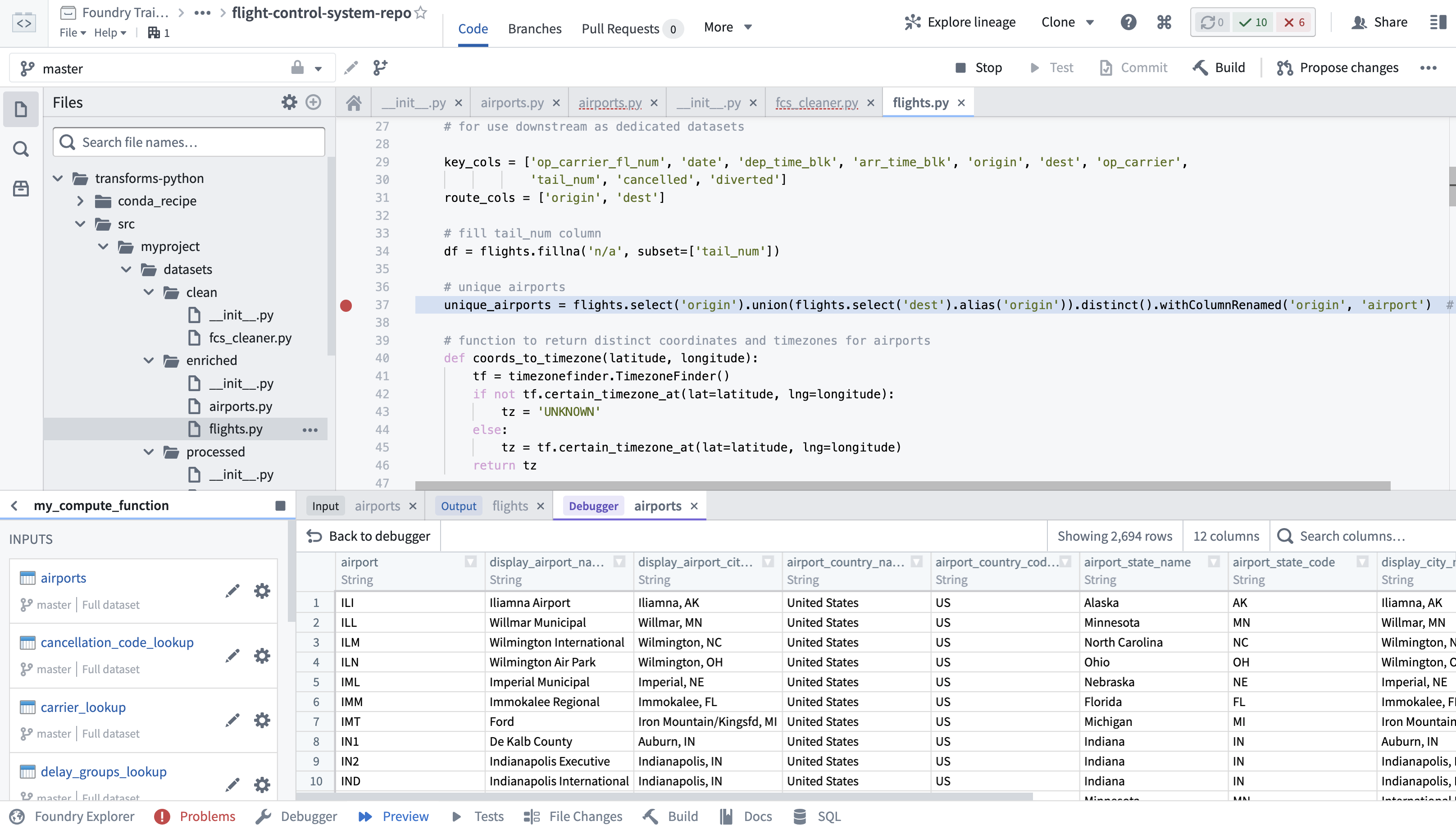
Consider using tools like version control systems and knowledge management platforms to keep track. Create a matrix to map out what needs to be transferred. For example:

Conducting Knowledge Transfer Sessions
A one-time handover is not enough. Plan multiple knowledge transfer sessions. These sessions should be interactive. They should allow the new partner to ask questions. They should be recorded. This is key. Recorded sessions serve as reference points for later review.

Set up a schedule that mirrors your timeline. Start with basic overviews. Then move on to deep dives into critical areas. Encourage a culture of inquiry. Let the new team know that no question is too small. This openness fosters trust and accelerates the learning curve.
Managing the Overlap Period
If possible, arrange for a period of overlap. This is when both the old and new partners work together. It’s not always possible, but it can make a big difference. During this time, the old partner can provide real-time support to the new team. They can help clarify nuances that may not be documented.
This overlap period is like a safety net. It catches errors. It prevents misinterpretations. And it speeds up the transition. Plan it carefully. Define its scope. And ensure both teams understand their roles.
Using Technology for a Smooth Transition
In today’s digital landscape, technology is your friend. The right tools can make the transition smoother. They can help maintain continuity and streamline communication.
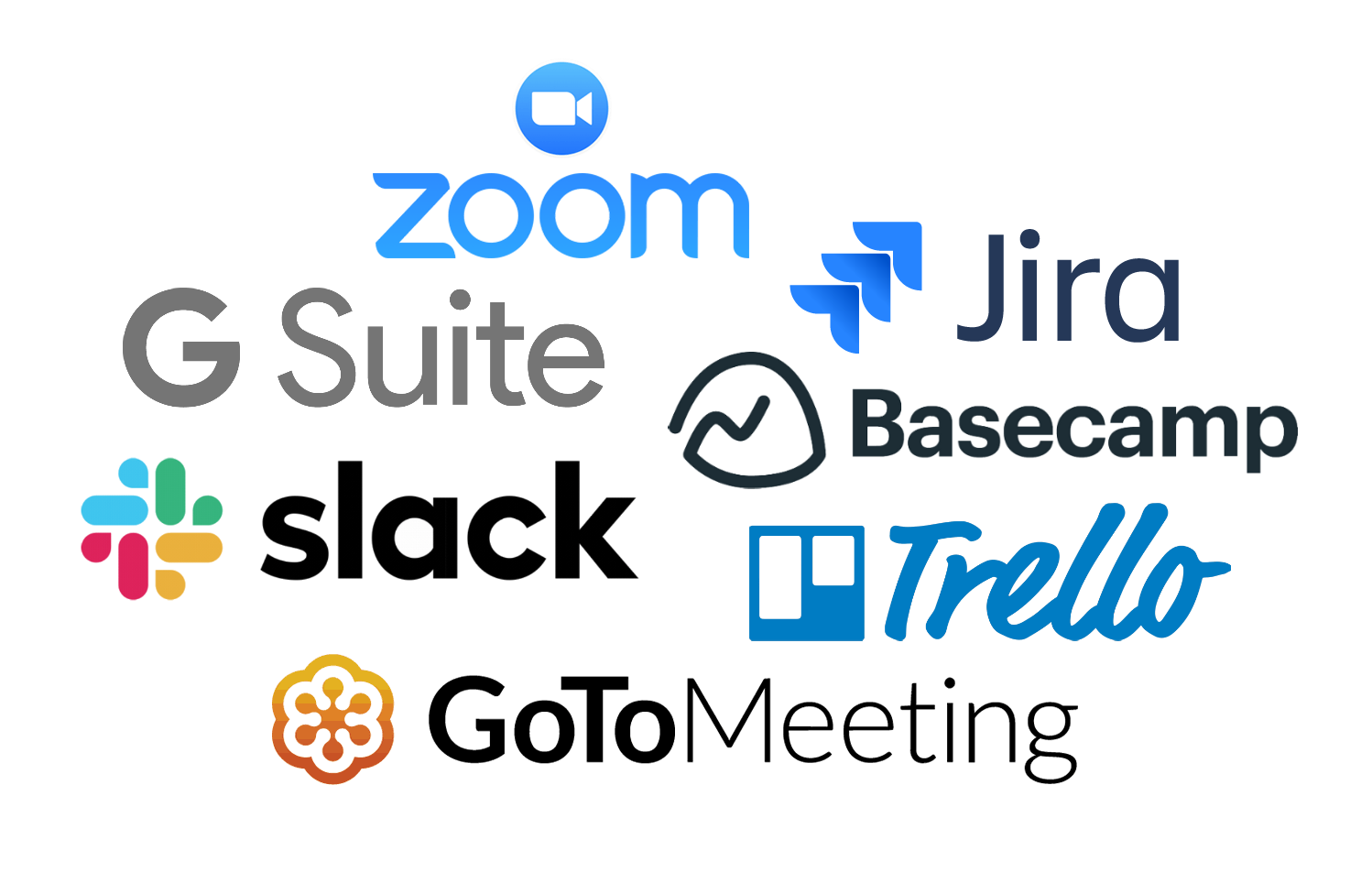
Collaboration Tools
Use collaboration tools to keep everyone on the same page. Tools like Slack, Microsoft Teams, or Zoom facilitate real-time communication. They allow for quick problem-solving and foster a sense of community among dispersed teams.
In addition, project management platforms like Jira, Trello, or Asana provide visibility into progress. They enable you to track tasks, assign responsibilities, and monitor deadlines. A centralized dashboard is invaluable during a transition. It keeps every stakeholder informed and accountable.

Documentation Platforms
Robust documentation platforms are essential. Tools like Confluence or Notion allow you to create, update, and share documentation easily. They serve as the single source of truth for all project-related information. These platforms also support version control, ensuring that you always have access to historical data.
Invest in a documentation system that is user-friendly. Train your team to use it effectively. A well-maintained repository can dramatically reduce transition headaches.

Automation and CI/CD Pipelines
Automation is a lifesaver during transitions. Implement Continuous Integration and Continuous Deployment (CI/CD) pipelines to ensure that code quality remains high. Automated tests catch issues early. They ensure that changes from the new partner do not break existing functionality.
Automate as many processes as possible. This reduces the risk of human error. And it makes the transition smoother. Use tools like Jenkins, GitLab CI, or CircleCI. These tools not only maintain quality but also provide transparency into the development process.
Recommended Tools for Transition

Post-Transition Best Practices
Even after the transition is complete, the work isn’t done. Post-transition, you need to ensure that everything remains on track. This is where post-transition best practices come in.
Conduct a Post-Mortem
Once the dust has settled, conduct a thorough post-mortem analysis. Gather your team—both in-house and from the new partner. Discuss what went well and what didn’t. Identify areas for improvement. Use this feedback to refine your processes for future transitions.
A structured post-mortem helps institutionalize lessons learned. It turns a one-time effort into a long-term improvement cycle. Document these insights. They are invaluable for future reference.
Monitor Performance Metrics
Set up performance metrics to track the success of the transition. Use key performance indicators (KPIs) to measure the new partner’s performance. These KPIs could include:
- Code Quality: Measured through code reviews and automated testing metrics.
- Delivery Timelines: Comparing planned versus actual delivery dates.
- Bug Rates: The number of bugs reported post-transition.
- Client Satisfaction: Through surveys and feedback sessions.
Monitor these metrics regularly. They offer a clear picture of how well the new partnership is working. And they provide actionable insights if adjustments are needed.
Continuous Improvement
The technology landscape is always changing. Your processes need to evolve too. Embrace continuous improvement. Regularly update your documentation, communication protocols, and collaboration tools. Stay abreast of industry trends. For example, a recent survey from TechRepublic found that companies with agile transition processes improved project delivery times by 18% on average.
This continuous improvement isn’t just about efficiency. It’s about staying competitive. It’s about ensuring that your software development processes remain cutting edge. And it’s about building a resilient outsourcing model that can adapt to change.
Foster a Collaborative Culture
A successful transition is not just about systems and processes. It’s about people. Build a culture of collaboration. Encourage your new partner to integrate with your in-house team. Organize joint training sessions, team-building exercises, and regular cross-team meetings.
When people work together, issues are resolved faster. When teams collaborate, innovation flourishes. The human element is the most critical aspect of any outsourcing relationship. Nurture it. Celebrate small wins. And keep the lines of communication open.

Financial and Legal Considerations
Switching outsourcing partners isn’t just a technical and operational challenge. It also involves financial and legal considerations. Overlooking these can lead to unexpected costs or disputes down the line.
Budgeting for the Transition
Transitions can be expensive. There are hidden costs that many overlook. Budgeting accurately is crucial. Factor in the costs of knowledge transfer sessions, overlap periods, and potential delays. Also, consider the costs associated with setting up new systems or tools that the new partner may require.
Perform a detailed cost analysis. Compare it to the potential long-term benefits. In many cases, investing in a smooth transition will save money in the long run by avoiding costly disruptions.
Contractual Obligations
Review your current contracts carefully. Look for clauses related to exit strategies, data ownership, and intellectual property. Ensure that all agreements are in place to facilitate a smooth transition. You may need to negotiate terms with both the outgoing and incoming partners.
It might be wise to involve legal counsel. A lawyer with experience in outsourcing contracts can help navigate complex issues. They can ensure that your company is protected and that the transition adheres to all legal requirements.
Risk Mitigation Through SLAs
Service Level Agreements (SLAs) play a crucial role during and after the transition. SLAs outline the expected performance levels. They can include penalties for non-compliance. During the transition, update your SLAs to reflect the new reality. Clearly define the metrics for success.
A well-crafted SLA minimizes the risk of disputes. It provides a clear framework for performance evaluation. And it sets the tone for a mutually beneficial relationship with your new partner.
Case Studies and Real-World Examples
Let’s talk specifics. I’ve seen several transitions over the years. Each had its own challenges and triumphs. I want to share two case studies that illustrate the process.
Case Study 1: The Rapid Transition
A client of ours needed to switch partners in less than three months. It was a high-stakes situation. The project was mid-development, and time was of the essence. Here’s how we handled it:
- Assessment: We quickly audited all documentation. We identified critical areas where knowledge transfer was paramount.
- Team Formation: We formed a cross-functional team that included members from both the old and new partners.
- Overlap: We instituted a two-week overlap period. This allowed the outgoing team to shadow the incoming one.
- Communication: Daily stand-ups ensured that issues were immediately flagged and resolved.
The result? We achieved continuity with minimal disruption. The project timeline was extended by only a few days. And client satisfaction remained high. This experience reinforced that even under tight timelines, a well-structured plan can deliver results.
Case Study 2: The Complex Migration
Another client had multiple projects running concurrently. Their previous partner was handling several critical systems. The switch was complex. Here’s our approach:
- Phased Transition: We broke the transition into phases. We started with non-critical projects. Once the new partner proved their competence, we moved on to the core systems.
- Detailed Documentation: We created extensive documentation. This included architecture diagrams, API documentation, and historical context for major decisions.
- Regular Audits: Throughout the transition, we held weekly audits. These ensured that the new partner was meeting all SLAs and quality benchmarks.
- Feedback Loops: Post-transition, we organized feedback sessions with both teams. This allowed us to refine our processes continually.
The complex migration took longer than the rapid transition. However, the outcome was just as successful. Continuity was maintained. The new partner was fully integrated. And the client was pleased with the results.
These case studies are not just success stories. They are lessons. They underscore the importance of planning, communication, and flexibility. They show that no two transitions are the same. And they prove that with the right approach, even the most complex migrations can be handled seamlessly.
Lessons Learned and Final Thoughts
Transitioning outsourcing partners is a journey. It’s filled with challenges, but it’s also filled with opportunities. The key lessons are clear.
Detailed Planning is Non-Negotiable
A robust plan is your best defense. Don’t rush. Take the time to assess, plan, and communicate. Every detail matters. From the technical handoff to the personal interactions, every aspect of the transition should be managed meticulously. It’s like changing a tire on a moving car. You need precision. You need focus.
Communication Builds Trust
Whether it’s internal or external, communication is the glue that holds everything together. Keep your teams informed. Be transparent with clients. And set up regular check-ins. Trust is built through consistent, clear dialogue. And that trust is what will carry your project through the storm.
Embrace Flexibility
Even the best-laid plans can run into unexpected issues. Flexibility is key. Be ready to adapt. If a knowledge transfer session reveals gaps in documentation, address them immediately. If a timeline needs adjusting, communicate that change clearly. Your ability to pivot in response to new challenges is what will ensure long-term success.
Invest in the Right Tools
Technology isn’t just a convenience. It’s a necessity. Collaboration tools, documentation platforms, and automation systems are the backbone of a successful transition. Invest in these tools. Train your team on their use. And keep them updated. The right technology can be the difference between a smooth transition and a chaotic one.
Legal and Financial Diligence
Don’t underestimate the financial and legal aspects. Overlooked contracts or mismanaged budgets can derail the best technical plans. Involve legal counsel. Conduct a detailed cost analysis. And always plan for contingencies. These measures protect your company and ensure that the transition doesn’t lead to unforeseen liabilities.
Final Checklist for a Seamless Transition
Before you embark on your next outsourcing transition, run through this final checklist:
- Assess Your Current Situation:
- Document all current processes, projects, and challenges.
- Evaluate the strengths and weaknesses of your current partner.
- Conduct a Risk Assessment:
- Identify potential pitfalls and quantify their impact.
- Develop mitigation strategies for each identified risk.
- Build a Detailed Transition Plan:
- Define clear objectives and measurable outcomes.
- Form a dedicated transition team with clear roles and responsibilities.
- Develop a realistic timeline and phase the transition if necessary.
- Set Up Communication Protocols:
- Establish regular check-ins for all teams involved.
- Create a communication plan for both internal and external stakeholders.
- Prepare for Knowledge Transfer:
- Inventory all critical documentation and code repositories.
- Plan for overlapping work periods to ensure real-time knowledge sharing.
- Use Technology:
- Utilize collaboration, documentation, and automation tools.
- Ensure that all tools are integrated and accessible to both teams.
- Handle Financial and Legal Aspects:
- Review and renegotiate contracts as necessary.
- Budget for the transition with a focus on mitigating hidden costs.
- Monitor and Evaluate:
- Track performance using KPIs like code quality, delivery timelines, and client satisfaction.
- Conduct post-transition reviews to capture lessons learned.
This checklist is your final safeguard. Use it to ensure that every critical element is addressed. When you’re thorough, the transition can be a period of renewal rather than disruption.



